Best panettone recipe for a buttery and mildly sweet Italian bread that is moist and soft inside. Using the same dough, we made it in two different flavors: candied fruit and also chocolate chip. It will be the star of your Christmas table (and Easter too)! Recipe adapted from Bauducco.
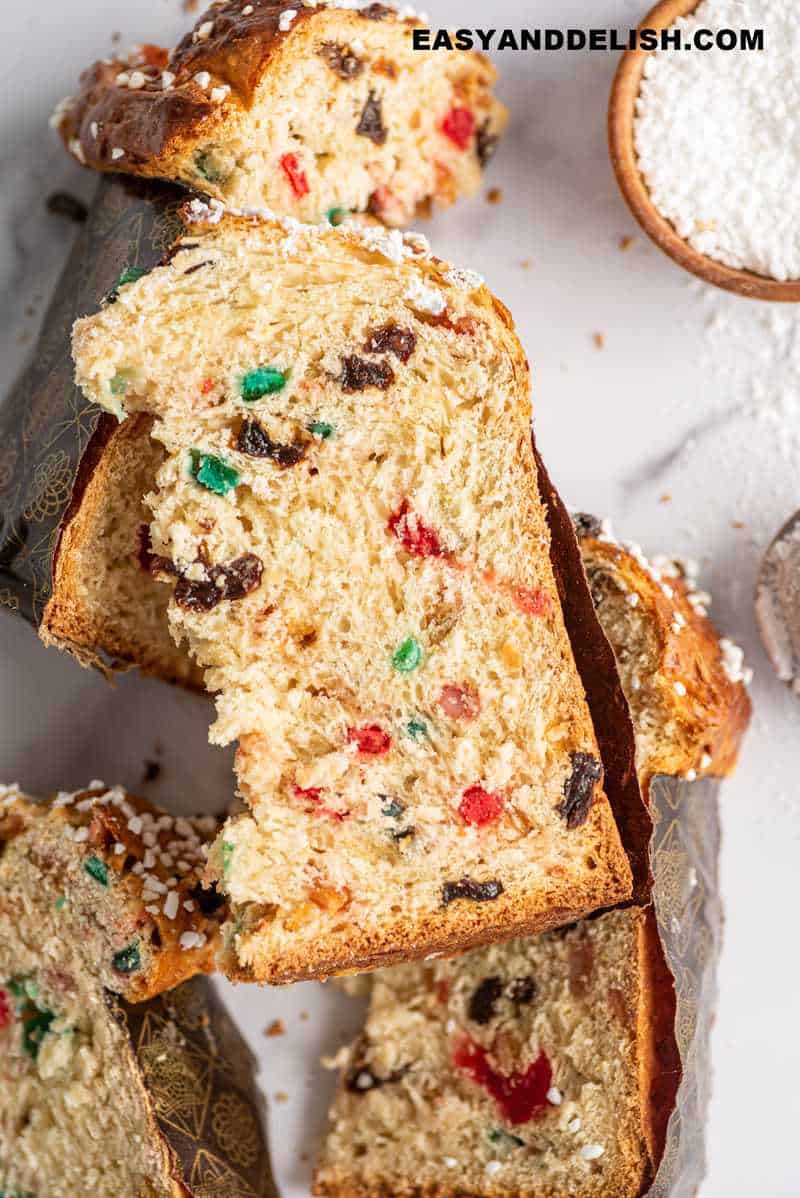
I grew up eating panettone in Brazil. The most well-known brand is Bauducco, which also manufactures it in the same flavors that we re-created for this panettone bread recipe.
Panettone is one of those Christmas traditions that I brought with me from there, and that I continue to enjoy with my family during the holidays in the USA.
In recent years, it has become quite popular in the USA, not only at Christmastime but also for Easter.
It has a dome shape and may look like a Christmas fruit cake, but is actually a type of bread.
Well, it contains yeast and goes through a fermentation process in order to rise. It is mildly sweet and its interior is softer than its exterior.
If you have never had it, you are missing out big time!
Table of Contents
- 1 Panettone Recipe
- 2 Is Panettone an Italian Christmas Cake or a Bread?
- 3 What is panettone bread?
- 4 When was the panettone recipe created?
- 5 Difference between Panettone and Pandoro
- 6 Ingredients
- 7 Equipment
- 8 How to make panettone
- 9 Useful tips for making the Best Panettone and Mini Panettone
- 10 Uses for panettone
- 11 Storage
- 12 Can panettone be frozen?
- 13 Other Christmas treats to enjoy:
- 14 Panettone Recipe (Bauducco Copycat)
Panettone Recipe
This panettone recipe is adapted from that of Bauducco, a famous Brazilian brand.
Unlike Bauducco's, our Italian sweet bread recipe has vanilla extract instead of barley malt extract, a different blend of candied fruits (Bauducco uses orange, papaya, and citron), and is topped with sugar pearls.
But the texture and taste are quite similar!
It is so versatile that you can customize it in different flavors, including adding cocoa powder to the dough.
You may add chopped dried fruit or nuts, vanilla bean seeds, etc
After the panettone is ready and has cooled completely, you can make panettone French toast, bread pudding, and even fill or top it with chocolate ganache, whipped cream, and more-- like a layered cake.
Is Panettone an Italian Christmas Cake or a Bread?
You may often see people referring to it as 'panettone cake.' But what actually is panettone: a bread or a cake?
Technically, it is a bread -- within the brioche family! This means it contains a mid-low hydration dough that uses eggs and milk instead of water and is enriched with butter and sugar.
But while French brioche can be made in hours, panettone takes days.
Some use a sourdough starter for panettone.
What is panettone bread?
Panettone is a traditional Italian sweet bread from Milan. It’s enjoyed around Christmas and New Year in many European and Latin American countries.
It is baked in a round mold and has a lighter-than-air fluffy texture. The traditional Italian panettone recipe contains candied orange, citron, and lemon zest, as well as raisins (added dry and not soaked).
But many other variations are available such as plain (vanilla) or chocolate chips. It pairs well with hot beverages or sweet wines such as Asti and Moscato d’Asti.
You can eat it plain, with mascarpone cream, or zabaione.
But you may try it toasted with butter or can use it to prepare other desserts, such as bread puddings.
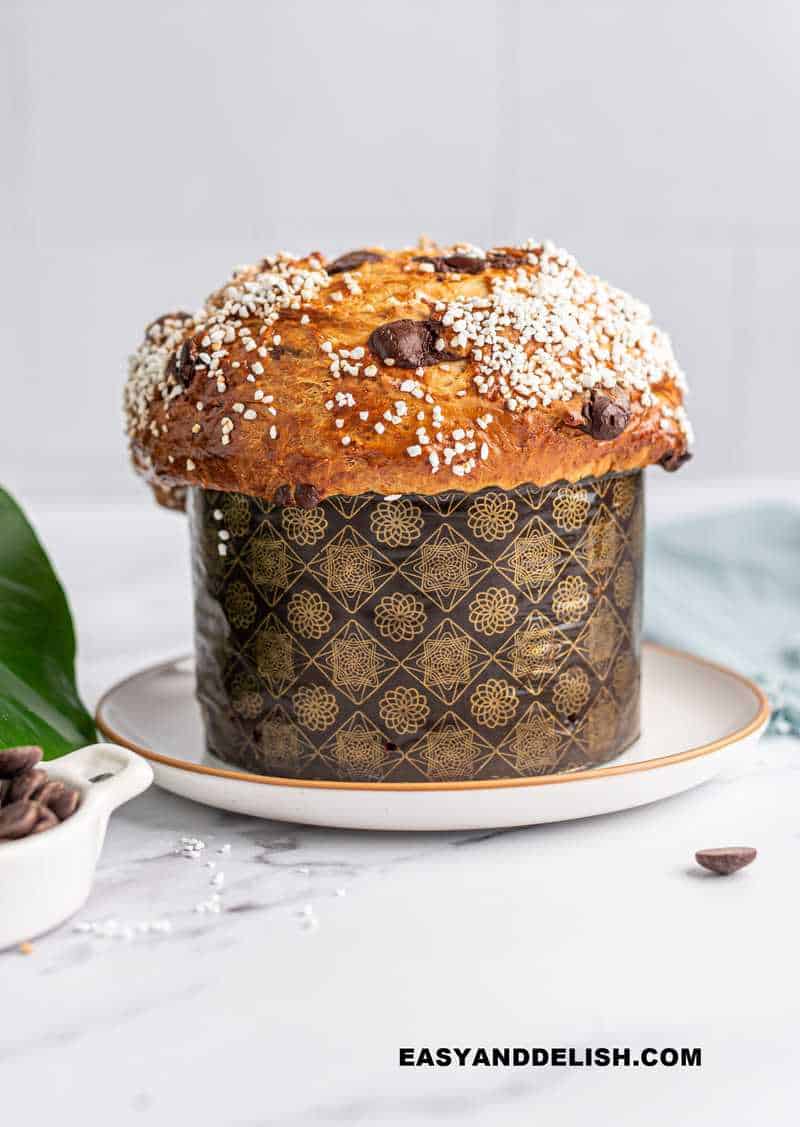
When was the panettone recipe created?
This recipe dates back to the Roman Empire. The Romans used to add honey to sweeten a type of leavened bread, which may have developed into the actual panettone (or pandoro). We will see the difference between them in a minute.
At that time wheat was a hot commodity, only used for special occasions such as Christmas.
The real tradition of making bread around the holidays began in the 1400s but the classic panettone only entered the scene in 1839.
There is more than one theory about its name. One of them says the name comes from the Italian word “panetto,” which means a ‘small bread loaf’. The word “one” was added to denote its actual size, a “large bread.”
Another theory states the name comes from the Milanese expression “pan de ton” (“luxury bread”) because of its expensive ingredients like butter, sugar, and raisins.
The thing is it broke frontiers and became popular in most of Europe and also in Latin American countries like Chile (Pan de Pascua), Argentina, Brazil (Panetone), Colombia (Panetón), Bolivia, Uruguay, Venezuela, Peru, and Paraguay, later on conquering the rest of the world.
Difference between Panettone and Pandoro
Panettone is a Christmas bread from Milan. It is sweet, yeasty, and has a domed or cylindrical shape. It is sometimes compared to fruitcake because the traditional recipes for both contain raisins and candied fruits.
On the other hand, Pandoro is a Christmas bread from Verona. Its name comes from ‘pan d’oro’ which means "golden bread." It has a bright yellow color, a star shape, and is dusted with powdered sugar.
Ingredients
FOR THE PANETTONE DOUGH
- Lukewarm water (85 F/29 C to 90 F/ 32 C)
- Instant yeast
- All-purpose flour
- Granulated sugar
- Salt
- Egg, at room temperature
- Lukewarm whole milk (85 degrees F/29 degrees C to 90 degrees F/ 32 degrees C)
- Vanilla extract
- Tightly packed orange zest
- Unsalted butter, cubed and room temperature
- Candied Fruit Mix
- Raisins
- Bittersweet chocolate chips
FOR THE TOPPING
- Beaten eggs
- Unsalted butter
- Swedish pearl sugar
Equipment
- Panettone pan or (Panettone paper molds in similar size)
- large and small bowls
- Brush
- Stand mixer
- small saucepan
- Rolling pin
How to make panettone
Make this panettone recipe in less time than the classic recipe as follows:
- Impastare (Yeast mixing): In the bowl of a stand mixer, whisk together ⅔ cup (160 g) lukewarm water with the yeast until dissolved. Add 2 cups (150 g) flour.
- Using the paddle attachment, beat at low speed until a stiff dough forms. NOTE: If the flour is not fully incorporated, knead dough in a bowl by hand until fully combined. Cover and let the dough rise in a warm, draft-free place (75° F/ 24° C) until doubled in size (about 15-20 minutes). NOTE: If you are in a cold place, place the bowl, covered, inside of the oven or microwave.
- Then add 4 cups (500 g) flour, granulated sugar, and salt to the yeast mixture. Add 4 eggs (200 g), lukewarm milk, vanilla, and orange zest. Beat everything at low speed until a shaggy dough forms, making sure to scrape the sides of the bowl.
- Switch to the dough hook attachment. Beat the dough at low speed until it is tacky, soft, smooth, and elastic (about 6 to 8 minutes). Add to the remaining ½ cup (62 g) flour, 2 tablespoons (28 g) at a time, beating until combined after each addition (3-4 minutes total). Add the butter, 2 tablespoon at a time, beating after each addition until combined. Make sure to beat until a soft, smooth, and elastic dough forms (5-7 minutes). Turn out dough onto a lightly floured surface, and shape it into a smooth round.
- Fermentazione (Fermentation): Lightly oil a large bowl and place the dough inside, turning to grease top. Cover and refrigerate overnight. Then remove the bowl from the fridge and let the dough rest at room temp for about 30 minutes for easy folding.
- Piegare (Folding): On a well-floured surface, divide the dough in half. Roll each dough into a ½-inch-thick oval (about 12 x 10 inches).
- Sprinkle one ball of dough with half of the drained candied fruits and raisin mixture. Use the palm of your hand instead of the rolling pin to gently press the fruit into the dough. Fold dough in half lengthwise. NOTE: Make sure to wipe off any excess liquid from the fruit. Roll dough into a ½-inch-thick oval. Sprinkle with the remaining fruit mixture. Press fruit into the dough, then fold the dough in half crosswise. Re-roll into a ½-inch-thick oval.
- Pirlatura (Dough rounding): Fold the dough, shape it into a ball, and place the seam side down, in a 5.9-inch-wide x 3.9-inch-high panettone paper mold (or one with similar measurements). Place the panettone mold on a double rimmed baking sheet. NOTE: If you use only one baking sheet instead of two, there is more chance of the bottom of the paper mold burning a little.
- Do the same with the other dough ball but use the chocolate chips instead. TIP: Make sure to place the two paper molds apart from each other (i.e. opposite sides of the baking sheet to leave room to rise).
- Cover and let rise in a warm, draft-free place (75° F/ 24°C) until doubled in size, about 1 to 2 hours, or until it reaches the rim of the paper mold.
- Position the oven wire rack in the bottom third of the oven. Preheat the oven to 375° F (190° C).
- In a small bowl, lightly whisk the remaining 2 eggs (100 g). Brush the top of the 2 bread loaves with egg; sprinkle with pearl sugar.
- Scarpatura (Scoring): Using a sharp paring knife, score the top of each loaf with an “X” and place a pat of butter onto the “X”.
- Bake for about 12 to 15 minutes or until just starting to brown. Then reduce the oven temperature to 350° F (180° C) and bake for 40-50 minutes or until deep golden brown (and an instant-read thermometer inserted in center registers 190° F or 88° C). Make sure to cover each loaf with aluminum foil after 10 minutes of baking to prevent excess browning.
- As soon as you remove the 2 panettones from the oven, insert 2 or more (as many as needed to hold the base) long wood skewers through the base of each panettone (going from one side through to the other) and hang each panettone upside down and let them cool completely. NOTE: You can use the clean bowl of your stand mixer as the base to hang the panettone. Some people use the back of two chairs placed just a little apart as the base to hang the ends of the skewer. IMPORTANT: They have to cool upside down; otherwise their tops will deflate and the dough (interior) will be mushy and heavy. Do NOT let the top of the panettone hang upside down touching a surface; otherwise, it will deflate.
- Once they cool, remove the skewers carefully and enjoy a slice.
WATCH OUR QUICK VIDEO TO SEE HOW TO MAKE PANETTONE STEP-BY-STEP!
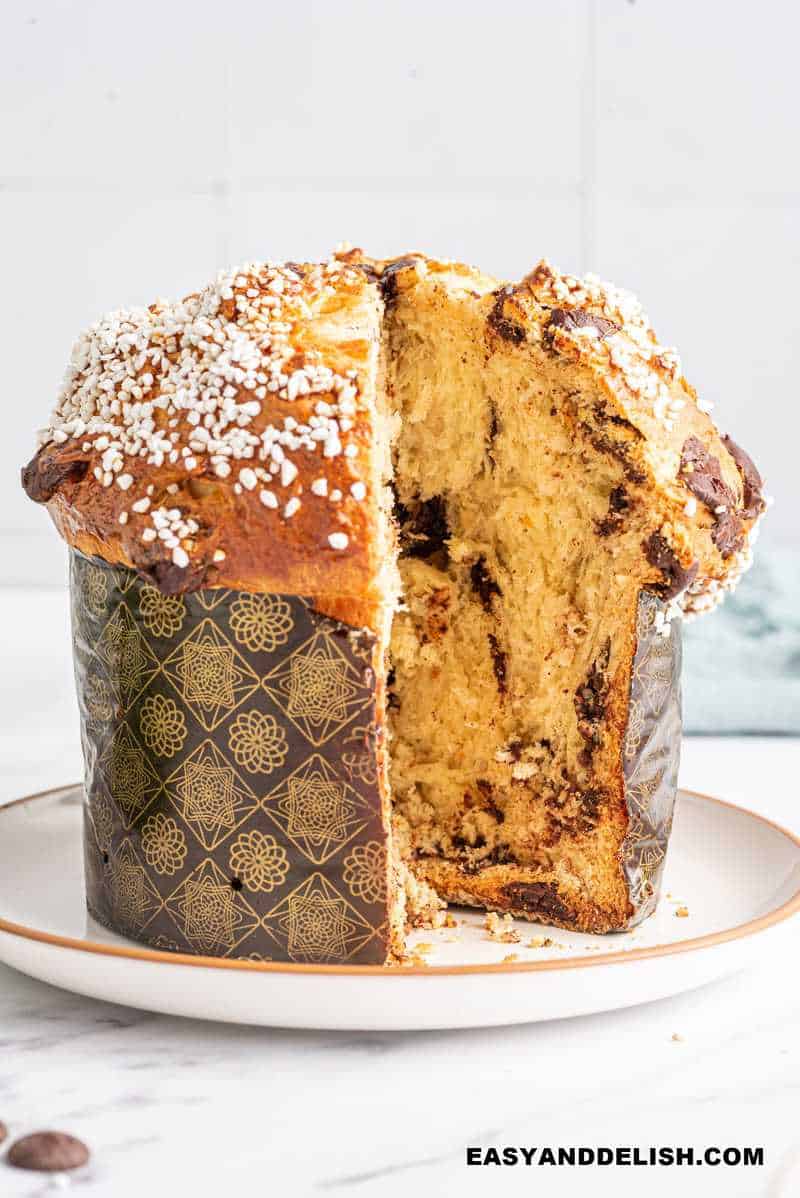
Useful tips for making the Best Panettone and Mini Panettone
Here are a few tips for the best Panettone:
- Don’t rush! The recipe is easy yet time-consuming. It takes days to make panettone properly!
- Let the dough rise twice in a warm place. If you are making panettone during the wintertime, preheat your oven to 350 degrees F for 2 minutes and then turn it off. Put in your panettone dough, covered, and let it rise inside the warm oven.
- After baking it, hang it upside down by piercing the base with long metal or wooden skewers in order to let it cool completely and avoid collapsing (losing its shape and becoming too dense).
- Keep it fresh for up to one week at room temperature. To do that, wrap it with cling film.
- To make a mini panettone recipe, divide our dough into several small pieces and use mini panettone paper molds.
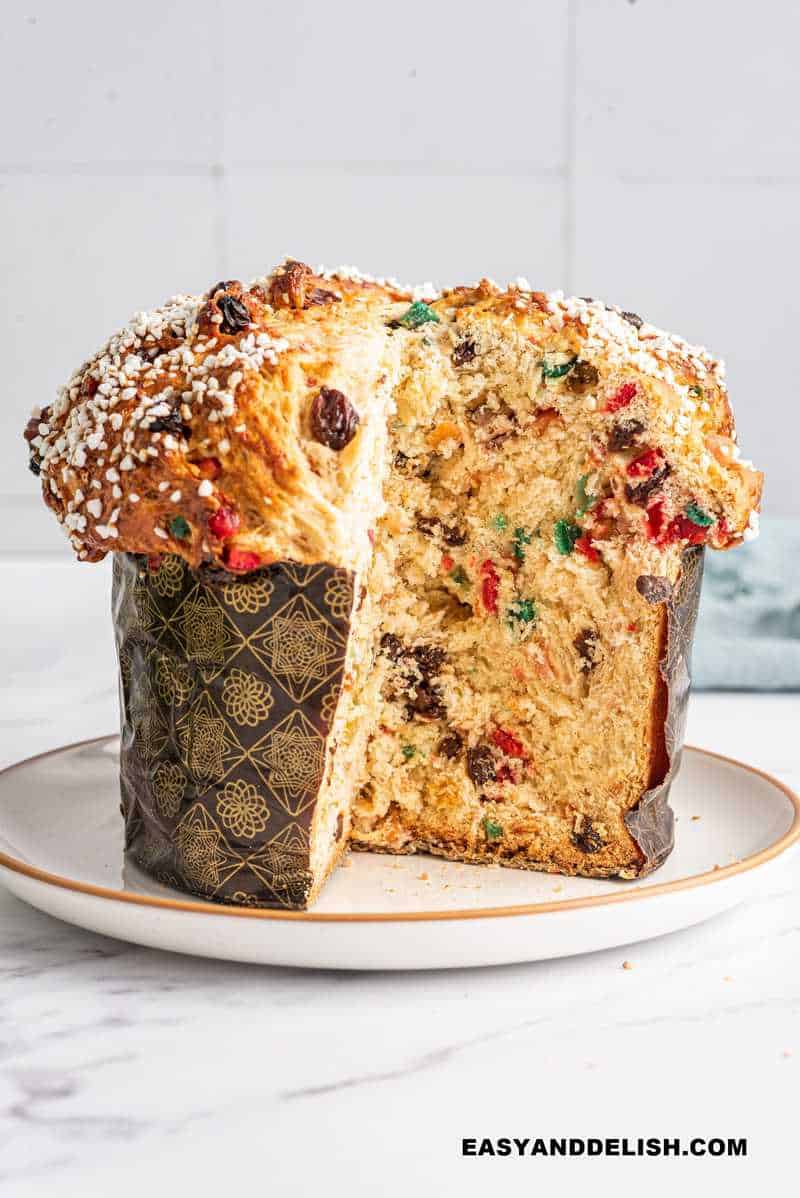
Uses for panettone
No, you don’t have to just enjoy it plain or as a bread. Here are a few other things you can make with it:
- Use it as a base for Panettone French toast, French toast casserole (replace brioche), or bread pudding.
- Slice as bread and toast it with butter in the oven until golden brown.
- Make sweet grilled sandwiches by spreading peanut butter and jelly or Nutella and marshmallow cream between 2 slices of panettone.
- Slice it as a layered cake and fill and top it with whipped cream and strawberries-- such as this Panettone Shortcake -- or make a Baked Alaska Panettone.
- Use it as a filling for homemade Easter chocolate eggs.
Storage
To prevent it from drying out, keep it at room temperature for up to 1 week, wrapped in plastic wrap.
Can panettone be frozen?
Yes, freeze it well wrapped, whole, or sliced, for up to 1 month.
If sliced, wrap each individually and then store them in an airtight container or sealable bag.
Thaw homemade panettone overnight in the fridge and reheat until warm in the oven. Serve right away!
Other Christmas treats to enjoy:
- Pavlova
- Chocolate Pie with Meringue
- Hot Chocolate Fudge
- Rabanadas (Brazilian French Toast)
- Honey Cakes
- Gingerbread Cookie Bars
- Gluten-Free Ginger Molasses Cookies
- Hot Chocolate Bombs
PIN & ENJOY!
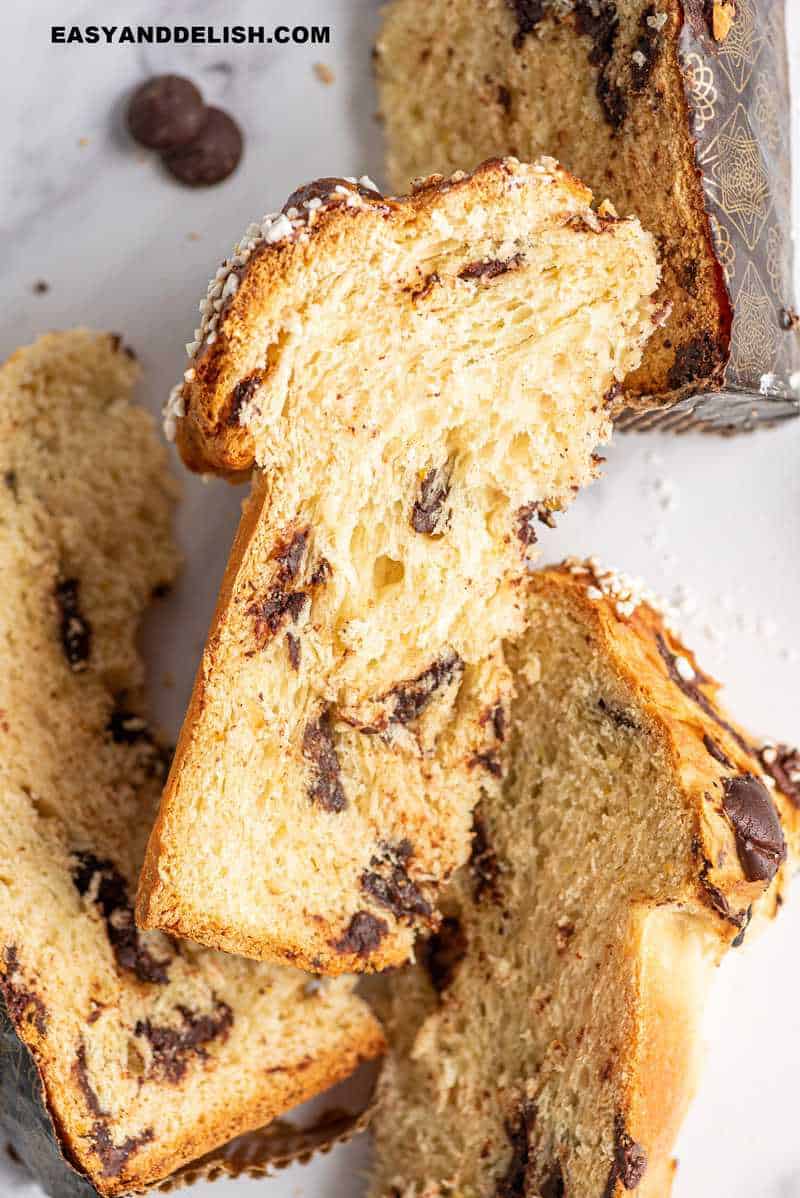
Panettone Recipe (Bauducco Copycat)
Equipment
- Panettone pan or (Panettone paper molds in similar size)
- large and small bowls
- brush
- Stand mixer
- small saucepan
- Rolling pin
Ingredients
- ⅔ cup lukewarm water (85° F/29° C to 90° F/ 32° C) or 160 g (IN GRAMS, NOT ML)
- 4 ½ teaspoons instant yeast
- 6 to 6 ½ cups all-purpose flour, divided 750 to 812 g
- ½ cup granulated sugar 100 g
- 4 ½ teaspoons salt
- 6 large eggs 300 g, at room temperature and divided
- ⅔ cup lukewarm whole milk or 160 g (Weight, not volume) (TEMP: 85° F/29 C to 90° F/ 32° C)
- 4 teaspoons vanilla extract 16 g
- 3 teaspoons tightly packed orange zest
- ⅔ cups unsalted butter, cubed and room temperature 152 g
- 4.5 oz Candied Fruit Mix drained (or 130 g. It comes already chopped and if you don’t drain excess moisture it will change the texture of the panettone)
- 4 oz raisins or 100 g. The candied fruits and raisins are for the candied fruit panettone only. Mix them together before adding to the dough
- 7 oz bittersweet chocolate chips (or milk chocolate chips if desired) or 200 g. These are for the chocolate chip panettone only
- 4 teaspoons Swedish pearl sugar OPTIONAL
Instructions
- Impastare (Yeast mixing): In the bowl of a stand mixer, whisk together ⅔ cup (160 g) lukewarm water with the yeast until dissolved. Add 2 cups (150 g) flour.
- Using the paddle attachment, beat at low speed until a stiff dough forms. NOTE: If the flour is not fully incorporated, knead dough in a bowl by hand until fully combined.
- Cover and let the dough rise in a warm, draft-free place (75° F/ 24° C) until doubled in size (about 15-20 minutes). NOTE: If you are in a cold place, place the bowl, covered, inside of the oven or microwave.
- Then add 4 cups (500 g) flour, granulated sugar, and salt to the yeast mixture. Add 4 eggs (200 g), lukewarm milk, vanilla, and orange zest. Beat everything at low speed until a shaggy dough forms, making sure to scrape the sides of the bowl.
- Switch to the dough hook attachment. Beat the dough at low speed until it is tacky, soft, smooth, and elastic (about 6 to 8 minutes). Add up to the remaining ½ cup (62 g) flour, 2 tablespoons (28 g) at a time, beating after each addition until combined (3-4 minutes total).
- Add the butter, 2 tablespoon at a time, beating after each addition until combined after each addition (3-4 minutes). Make sure to beat until a soft, smooth, and elastic dough forms (5-7 minutes). Turn out dough onto a lightly floured surface, and shape it into a smooth round.
- Fermentazione (Fermentation): Lightly oil a large bowl and place the dough inside, turning to grease top. Cover and refrigerate overnight. Then remove the bowl from the fridge and let the dough rest at room temp for about 30 minutes for easy folding.
- Piegare (Folding): On a well-floured surface, divide the dough in half. Roll each ball of dough into a ½-inch-thick oval (about 12 x 10 inches).
- Sprinkle one of the doughs with half of the drained candied fruits and raisin mixture. Use the palm of your hand instead of the rolling pin to gently press the fruit into the dough. Fold dough in half lengthwise. NOTE: Make sure to wipe off any excess liquid from the fruit. Roll dough into a ½-inch-thick oval. Sprinkle with the remaining fruit mixture. Press fruit into dough, then fold the dough in half crosswise. Re-roll into a ½-inch-thick oval.
- Pirlatura (Dough rounding): Fold the dough, shape it into a ball, and place the seam side down, in a 5.9-inch-wide x 3.9-inch-high panettone paper mold (or one with similar measurements). Place the panettone mold on a double rimmed baking sheet. NOTE: If you use only one baking sheet instead of two, there is more probability of the bottom of the paper mold burning a little.
- Do the same with the other dough but use the chocolate chips instead. TIP: Make sure to place the 2 paper molds apart from each other (opposite side of the baking sheet to have room to rise).
- Cover and let rise in a warm, draft-free place (75° F/ 24°C) until doubled in size, about 1 to 2 hours, or until it reaches the rim of the paper mold.
- Position the oven wire rack in the bottom third of the oven. Preheat the oven to 375° F (190° C).
- In a small bowl, lightly whisk the remaining 2 eggs (100 g). Brush the top of the 2 bread loaves with egg; sprinkle with pearl sugar.
- Scarpatura (Scoring): Using a sharp paring knife, score the top of each loaf with an “X” and place a pat of butter onto the “X”.
- Bake for about 12 to 15 minutes or until it is just starting to brown. Then reduce the oven temperature to 350° F (180° C) and bake for 40-50 minutes or until deep golden brown (and an instant-read thermometer inserted in the center registers 190° F or 88° C). Make sure to cover each loaf with aluminum foil after 10 minutes of baking to prevent excess browning.
- As soon as you remove the 2 panettones from the oven, insert 2 or more (as many as needed to hold the base) long wood skewer through the base of each panettone (going from one side through to the other) and hang each panettone upside down. Let them cool completely.
- NOTE: You can use the clean bowl of your stand mixer as the base to hang the panettone. Some people use the back of two chairs placed just a little apart as the base to hang the ends of the skewer. IMPORTANT: They have to cool upside down; otherwise their tops will deflate and the dough (interior) will be mushy and heavy. Do NOT let the top of the panettone hang upside down touching a surface; otherwise, it will deflate.
- Once they cool, remove the skewers carefully and enjoy a slice.
Recipe Video

Recipe Notes
Nutrition
** Nutrition labels on easyanddelish.com are for educational purposes only. This info is provided as a courtesy and is only an estimate, since the nutrition content of recipes can vary based on ingredient brand or source, portion sizes, recipe changes/variations, and other factors. We suggest making your own calculations using your preferred calculator, based on which ingredients you use, or consulting with a registered dietitian to determine nutritional values more precisely.
Please note that health-focused and diet information provided on easyanddelish.com is for educational purposes and does not constitute medical advice, nor is it intended to diagnose, treat, cure, or prevent disease. Consult with your doctor or other qualified health professional prior to initiating any significant change in your diet or exercise regimen, or for any other issue necessitating medical advice.



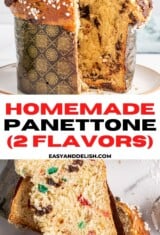
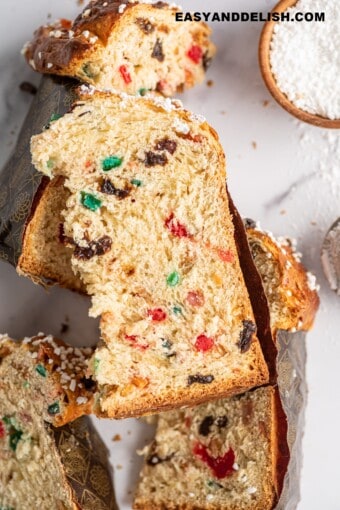
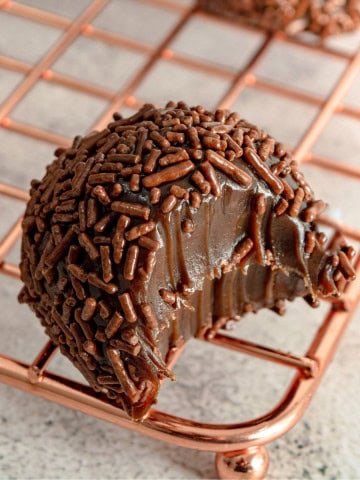
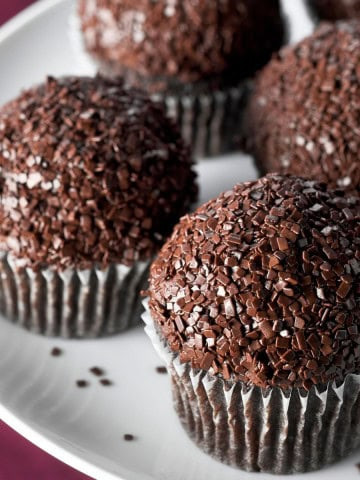


Denise says
Looks & Sounds Amazing. I can't wait to make this for the Holiday's. I might do a trial run ASAP. Thank You for the Beautiful Recipes.
Debbie says
Hi. Texture came out great but too much salt and it’s not as sweet as I wanted it. I’ll probably have to tweak it.
Denise Browning says
Hi Debbie! Panettone is a sweet bread, not a cake. Therefore, it cannot be so sweet but you can certainly add more sugar to yours to fit your tastebuds.
Sarah says
Recipe looks great, but when is the butter added? Thanks.
Denise Browning says
Hi Sarah! Thanks for calling it out! I have just fixed the recipe. When you switch to a hook attachment and after you add the remaining 1/2 cup of flour, you then add the butter. 2 tbsp at a time, beating after each addition until combined.
2pots2cook says
Sooooooo inviting ! Happy holidays Denise !
Denise Browning says
Thank you Davorka! Wishing youa very Merry Christmas. Panetonne has been a family tradition for me since I lived in Brazil and I still serve it here in the USA. It is so delicious!